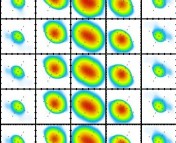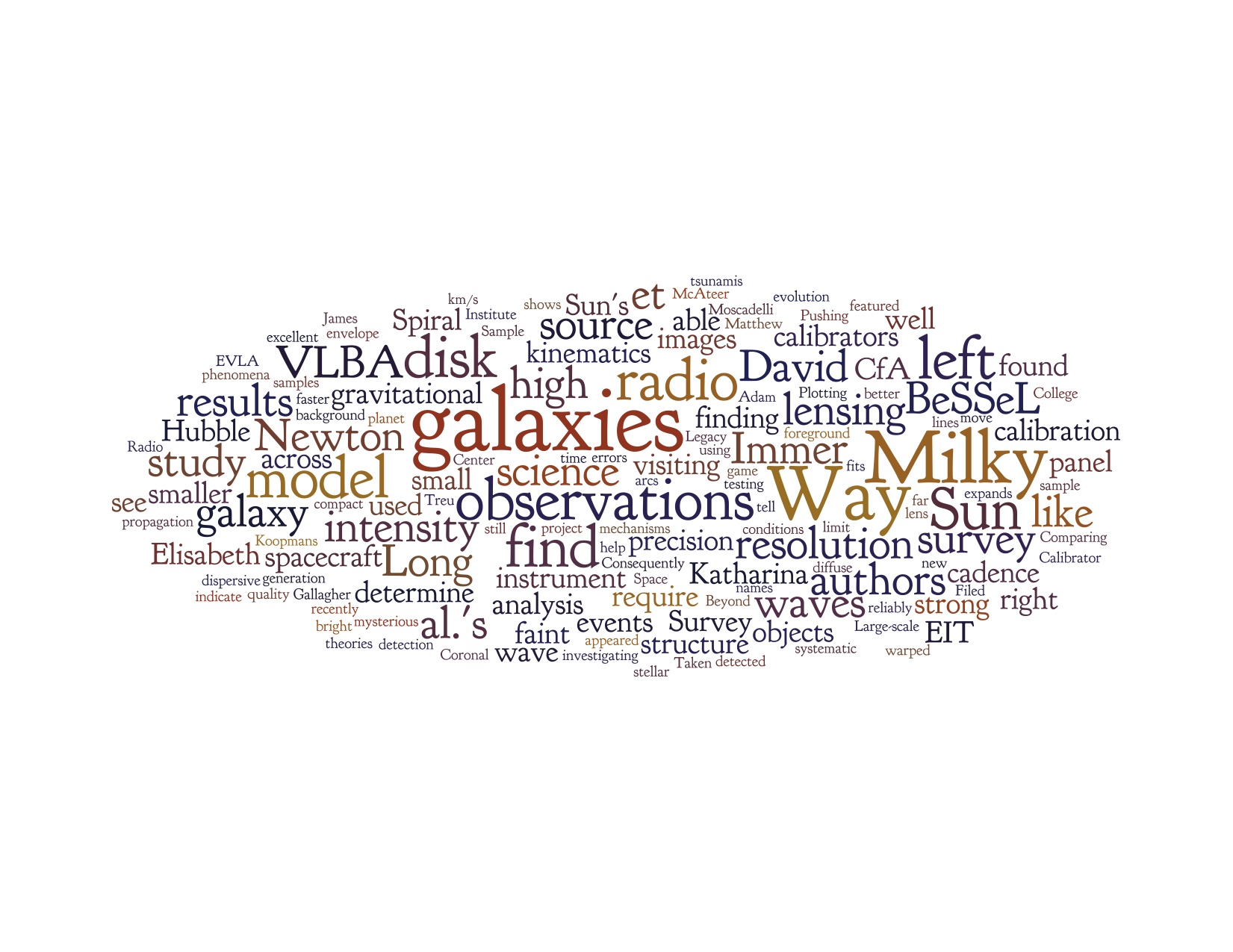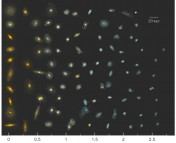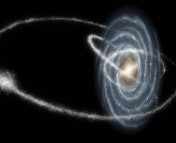Title: The SEDIGISM survey: First Data Release and overview of the Galactic structure
Authors: F Schuller, J S Urquhart, T Csengeri, D Colombo, A Duarte-Cabral, M Mattern, A Ginsburg, A R Pettitt, F Wyrowski, L Anderson, F Azagra, P Barnes, M Beltran, H Beuther, S Billington, L Bronfman, R Cesaroni, C Dobbs, D Eden, M-Y Lee, S-N X Medina, K M Menten, T Moore, F M Montenegro-Montes, S Ragan, A Rigby, M Riener, D Russeil, E Schisano, A Sanchez-Monge, A Traficante, A Zavagno, C Agurto, S Bontemps, R Finger, A Giannetti, E Gonzalez, A K Hernandez, T Henning, J Kainulainen, J Kauffmann, S Leurini, S Lopez, F Mac-Auliffe, P Mazumdar, S Molinari, F Motte, E Muller, Q Nguyen-Luong, R Parra, J-P Perez-Beaupuits, P Schilke, N Schneider, S Suri, L Testi, K Torstensson, V S Veena, P Venegas, K Wang, M Wienen
First Author’s Institution: Max-Planck-Institut für Radioastronomie, Auf dem Hügel 69, D-53121. Bonn, Germany
Status: Published in MNRAS [open access]
The Mysterious Milky Way
The Milky Way Galaxy is our home, and yet we don’t have a very clear picture of how it is structured. We know that we live inside a barred spiral galaxy, but how many spiral arms does our Galaxy have? Where are they located? How tightly are they wound? From our vantage point inside the Galaxy, we cannot yet say for sure! Without the luxury of a face-on view (like we have for many distant spiral galaxies), we have to make do with the embedded, edge-on observations that we can take from our little orbit around the Sun. Trying to understand the structure of our Galaxy from the Sun’s vantage point is like trying to count the grooves on a vinyl record from the perspective of a mote of dust stuck on the record’s surface. So how do we constrain the properties of our spiral arms given this limitation? Well, they can be traced by looking at the distribution of young stars (explored in detail in this recent astrobite), or the positions of newborn stars, which are formed preferentially where the gas density increases during the passage of a spiral arm, but these observations can be complicated by dust blocking our line of sight. This is particularly a problem in dusty regions like the inner Galaxy. A powerful alternative is to look at the distribution of the dense gas associated with the spiral arms and other features of the Milky Way.
Molecular Hydrogen and its CO-llaborators
Molecular hydrogen (H2) is the main component of this dense gas, and is vitally important for constraining the structure of our Galaxy. H2 constitutes the vast majority of the dense clouds where new stars form, and traces out the skeletons of spiral arms and other complexities of the dense interstellar medium composing our galaxy. Unfortunately, the lack of a dipole moment makes this molecule notoriously difficult to detect directly. Instead, we rely on tracer molecules like Carbon Monoxide (CO), which are known to coexist with H2. If we expect the H2 to be densest in the spiral arms, we’d expect to see the most CO emission there, and we can calculate the amount of molecular gas using the typical ratio of H2 to CO. While it’s not fully understood how the ratio of H2 to CO might vary across different environments, CO (and its less common isotopic variants 13CO and C18O) remains one of the most powerful tools for mapping out the otherwise invisible H2 that reveals the structure of our Galaxy (as well as that of other galaxies!).
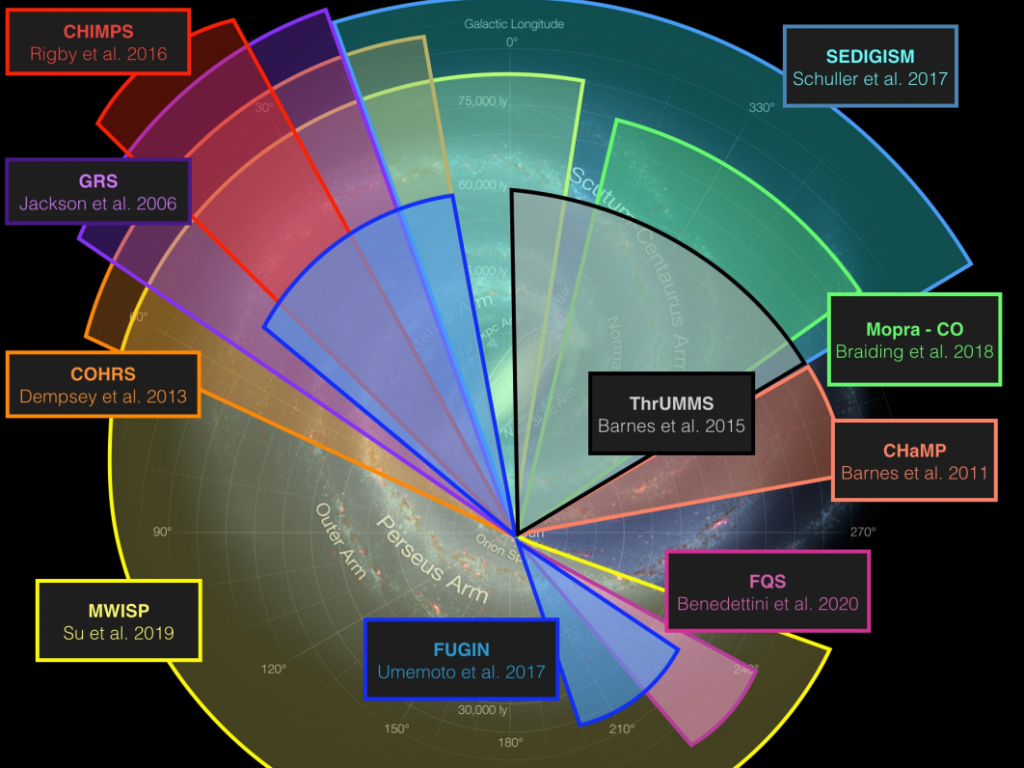
The SEDIGISM Survey
Determining the distribution of CO in our galaxy is a daunting task, given that the Milky Way occupies an enormous portion of the sky. There is a rich literature of large surveys mapping out swaths of the Galactic disk, and today’s paper introduces a huge wealth of new, CO observations of our galaxy from the SEDIGISM (Structure, Excitation and Dynamics of the Inner Galactic Interstellar Medium) survey, shedding new light on the structure of our Galaxy. The SEDIGISM team uses the Atacama Pathfinder EXperiment (APEX) telescope to observe the CO J=2-1 rotational transition, mapping out the spatial distribution and velocities of dense gas across a 84 square degree field of the Milky Way Disk. The authors explore the distribution of CO emission of the inner Milky Way from Galactic Longitude 18 to -60 degrees, visualized in relationship to previous CO surveys in Figure 1. With this paper, the cutting edge data from the SEDIGISM survey have been released for use by the scientific community, and will serve as an extraordinary resource of exploring the inner Galaxy.
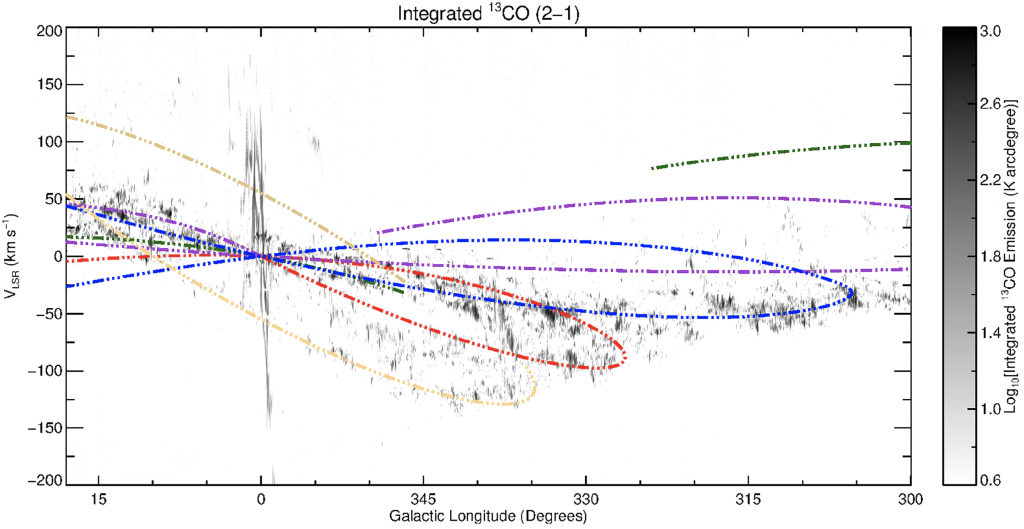
Interpreting the Galactic Distribution of CO
Even with such a wealth of data from all these enormous surveys, we still cannot see the 3-D spatial distribution of gas, so how can we identify the spiral arms? Fortunately, spiral arms have a very distinctive appearance if you look at the distribution of emission as a function of position vs. velocity. By considering models of how we would expect spiral arm models to look in this space, we can identify similar structures in CO emission as a function of Galactic longitude and line-of-sight velocity. The authors fit this longitude-velocity (l-v) distribution of CO to a four spiral arm model, finding their data agree very well with the existence of these four spiral arms. The structures corresponding to each spiral arm are highlighted in Figure 2 (also depicted as they might appear from a face-on perspective in Figure 3), and contain within them the majority (~60%) of the CO emission. Much of this emission is concentrated in clumpy complexes of dense gas, rather than being more smoothly distributed along the spiral arms.
In the inner few kiloparsecs of the Galaxy, the four spiral arms meet in the Galactic Bar (sounds like the setup for a bad joke…), and the innermost few degrees of the Galaxy is where things get really messy. The Galactic Center region is famously kinematically complex, with highly non-circular orbits making it more difficult to interpret structures in (l-v) space. Even still, these data will act as a powerful resource for untangling the interactions of the spiral arms, the Galactic Bar, and the Galactic Center in future work. The SEDIGISM survey will be used to explore much more than the spiral arm distribution, with both parallel and future publications focusing on the distribution and properties of star forming regions throughout the Galaxy, and with the first data release being publicly available, more exciting results will undoubtedly follow!

Astrobite edited by Olivia Rae Cooper
Featured image credit: Credit: NASA, ESA, K. Kuntz (JHU), F. Bresolin (University of Hawaii), J. Trauger (Jet Propulsion Lab), J. Mould (NOAO), Y.-H. Chu (University of Illinois, Urbana), Canada-France-Hawaii Telescope/J.-C. Cuillandre/Coelum, and G. Jacoby, B. Bohannan, and M. Hanna/NOAO/AURA/NSF

